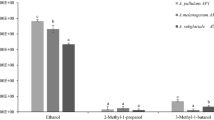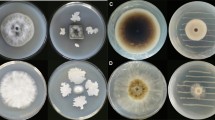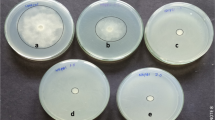Abstract
Botrytis cinerea is one of the most destructive pathogens of cherry tomatoes during preharvest and postharvest phase. Our previous study demonstrated that volatile organic compounds (VOCs) produced by Hanseniaspora uvarum could markedly suppress the mycelium growth and conidia germination of B. cinerea. However, the main inhibitory VOCs of H. uvarum are not fully clear. In this study, a total of 21 volatile organic monomers (VOMs) of H. uvarum were tested for their antifungal activity against B. cinerea in vitro. It was found that trans-cinnamaldehyde, 2-nonanone, ethyl caprylate, benzyl alcohol, hexanoic acid, hexyl alcohol, isobutyl acetate, ethyl propionate, isoamyl acetate, ethyl 2-methylbutyrate, phenethyl alcohol, ethyl acetate, 4-ethylphenol, 3-phenyl-1-propanol, ethyl cinnamate, 3-methyl-1-butanol, and ethyl 3-hydroxybhexanoate could significantly inhibit mycelium growth within 3 days at higher concentrations, whereas ethyl 3-hydroxybutyrate, ethyl caprate, decanoic acid, and lauric acid exhibited a lower inhibition. Furthermore, the five VOMs, including trans-cinnamaldehyde, 2-nonanone, ethyl caprylate, benzyl alcohol, and hexanoic acid, also had the efficiency on inhibiting conidia germination. In particular, trans-cinnamaldehyde was the best inhibitor of mycelium growth and conidia germination. Hence, trans-cinnamaldehyde was also tested in vivo as postharvest biofumigants. In vivo assay showed that trans-cinnamaldehyde could significantly reduce B. cinerea infection of cherry tomatoes and maintain fruit hardness, color, total soluable solids, and titratable acidity under conditions of artificial and natural infection. Collectively, these results indicated that trans-cinnamaldehyde, the main inhibitory VOMs of H. uvarum, has the potential for effectively controlling postharvest gray mold of cherry tomatoes and maintaining fruit quality in commercial application.





Similar content being viewed by others
References
Abarca, R. L., Rodríguez, F. J., Guarda, A., Galotto, M. J., & Bruna, J. E. (2016). Characterization of beta-cyclodextrin inclusion complexes containing an essential oil component. Food Chemistry, 196, 968–975.
Bang, K. H., Lee, D. W., Park, H. M., & Rhee, Y. H. (2000). Inhibition of fungal cell wall synthesizing enzymes by trans-cinnamaldehyde. Bioscience, Biotechnology, and Biochemistry, 64(5), 1061–1063.
Cai, Z. K., Yang, R., Xiao, H. M., Qin, X. J., & Si, L. Y. (2015). Effect of preharvest application of Hanseniaspora uvarum, on postharvest diseases in strawberries. Postharvest Biology and Technology, 100(100), 52–58.
Calvo, J., Calvente, V., Orellano, M. E., Benuzzi, D., & Sanz, M. I. (2010). Control of Penicillium expansum and Botrytis cinerea on apple fruit by mixtures of bacteria and yeast. Food and Bioprocess Technology, 3(5), 644–650.
Aquino, D., S., Mistriotis, A., Briassoulis, D., Di Lorenzo, M. L., Malinconico, M., & Palma, A. (2016). Influence of modified atmosphere packaging on postharvest quality of cherry tomatoes held at 20 °C. Postharvest Biology and Technology, 115, 103–112.
Di Francesco, A., Ugolini, L., Lazzeri, L., & Mari, M. (2015). Production of volatile organic compounds by Aureobasidium pullulans as a potential mechanism of action against postharvest fruit pathogens. Biological Control, 81, 8–14.
Fathi, Z., Hassani, A., Ghosta, Y., Abdollahi, A., & Meshkatalsadat, M. H. (2013). The potential of thyme, clove, cinnamon and ajowan essential oils in inhibiting the growth of Botrytis cinerea and Monilinia fructicola. Journal of essential oil-bearing plants JEOP., 15(1), 38–47.
Gabler, F. M., Fassel, R., Mercier, J., & Smilanick, J. K. (2006). Influence of temperature, inoculation interval, and dosage on biofumigation with Muscodor albus to control postharvest gray mold on grapes. Plant Disease, 90(8), 1019–1025.
Gao, Z. F., Zhang, B. J., Liu, H. P., Han, J. C., & Zhang, Y. J. (2017). Identification of endophytic Bacillus velezensis ZSY-1 strain and antifungal activity of its volatile compounds against Alternaria solani and Botrytis cinerea. Biological Control, 105, 27–39.
Guerra, I. C. D., de Oliveira, P. D. L., de Souza Pontes, A. L., Lúcio, A. S. S. C., Tavares, J. F., Barbosa-Filho, J. M., Madruga, M. S., & de Souza, E. L. (2015). Coatings comprising chitosan and Mentha piperita L. or Mentha×villosa Huds essential oils to prevent common postharvest mold infections and maintain the quality of cherry tomato fruit. International Journal of Food Microbiology, 214, 168–178.
Hassani, A., Fathi, Z., Ghosta, Y., Abdollahi, A., Meshkatalsadat, M.H., Marandi, R.G., (2011). Evaluation of plant essential oils for control of postharvest brown and gray mold rots on apricot.. Journal of Food Safety. 32, 94–101.
Hassani, A., Fathi, Z., Ghosta, Y., Abdollahi, A., Meshkatalsadat, M. H., & Marandi, R. J. (2012). Evaluation of plant essential oils for control of postharvest brown and gray mold rots on apricot. Journal of Food Safety, 32(1), 8.
He, S. K., Ren, X. Y., Lu, Y. F., Zhang, Y. B., Wang, Y. F., & Sun, L. J. (2016). Microemulsification of clove essential oil improves its in vitro and in vivo control of Penicillium digitatum. Food Control, 65, 106–111.
Huang, F., Kong, J., Ju, J., Zhang, Y., Guo, Y. H., Cheng, Y. L., Qian, H., Xie, Y. F., & Yao, W. Y. (2019). Membrane damage mechanism contributes to inhibition of trans-cinnamaldehyde on Penicillium italicum using surface-enhanced Raman spectroscopy (SERS). Scientific Reports, 9(1).
Huang, R., Li, G. Q., Zhang, J., Yang, L., Che, H. J., Jiang, D. H., & Huang, H. C. (2011). Control of postharvest botrytis fruit rot of strawberry by volatile organic compounds of Candida intermedia. Phytopathology., 101(7), 859–869.
Kaewklin, P., Siripatrawan, U., Suwanagul, A., & Lee, Y. S. (2018). Active packaging from chitosan-titanium dioxide nanocomposite film for prolonging storage life of tomato fruit. International Journal of Biological Macromolecules, 112, 523–529.
Lai, J., Cao X., Yu, T., Wang, Q., Zhang, Y.W., Zheng, X.D., Lu, H.P., (2018). Effect of Cryptococcus laurentii on inducing disease resistance in cherry tomato fruit with focus on the expression of defense-related genes. Food Chemistry. 254, 208–216.
Larrigaudiere, C., Pons, J., Torres, R., & Usall, J. (2002). Storage performance of clementines treated with hot water, sodium carbonate and sodium bicarbonate dips. Journal of Pomology & Horticultural Science., 77(3), 314–319.
Li, Q.L., Ning, P., Zheng, L., Huang, J.B., Li,G.Q., Hsiang, T., 2012. Effects of volatile substances of Streptomyces globisporus JK-1 on control of Botrytis cinerea on tomato fruit. Biological Control 61(2), 113–120.
Lu, J. B., Charles, M. T., Vigneault, C., Goyette, B., & Raghavan, G. (2010). Effect of heat treatment uniformity on tomato ripening and chilling injury. Postharvest Biology and Technology, 56(2), 155–162.
Macías-Rubalcava, M. L., Sánchez-Fernández, R. E., Roque-Flores, G., Lappe-Oliveras, P., & Medina-Romero, Y. M. (2018). Volatile organic compounds from Hypoxylon anthochroum endophytic strains as postharvest mycofumigation alternative for cherry tomatoes. Food Microbiology, 76, 363–373.
Mari, M., Bautista-Baños, S., & Sivakumar, D. (2016). Decay control in the postharvest system: role of microbial and plant volatile organic compounds. Postharvest Biology and Technology, 122, 70–81.
Medina-Romero, Y. M., Roque-Flores, G., & Macías-Rubalcava, M. L. (2017). Volatile organic compounds from endophytic fungi as innovative postharvest control of Fusarium oxysporum in cherry tomato fruits. Applied Microbiology and Biotechnology, 101(22), 8209–8222.
Mehra, L. K., MacLean, D. D., Shewfelt, R. L., Smith, K. C., & Scherm, H. (2013). Effect of postharvest biofumigation on fungal decay, sensory quality, and antioxidant levels of blueberry fruit. Postharvest Biology and Technology, 85, 109–115.
Mercier, J., & Jiménez, J. I. (2004). Control of fungal decay of apples and peaches by the biofumigant fungus Muscodor albus. Postharvest Biology and Technology, 31(1), 1–8.
Navarta, L. G., Calvo, J., Posetto, P., Cerutti, S., Raba, J., Benuzzi, D., & Sanz, M. I. (2014). Postharvest control of gray mold in apples with lyophilized formulations of Cryptococcus laurentii: the effect of cold stress in the survival and effectiveness of the yeast. Food and Bioprocess Technology, 7(10), 2962–2968.
Neri, F., Mari, M., & Brigati, S. (2006). Control of Penicillium expansum by plant volatile compounds. Plant Pathology, 55(1), 100–105.
Neri, F., Marí, M., Brigati, S., & Bertolini, P. (2007). Fungicidal activity of plant volatile compounds for controlling Monilinia laxa in stone fruit. Plant Disease, 91(1), 30–35.
Oregel-Zamudio, E., Angoa-Pérez, M. V., Oyoque-Salcedo, G., Aguilar-González, C. N., & Mena-Violante, H. G. (2017). Effect of candelilla wax edible coatings combined with biocontrol bacteria on strawberry quality during the shelf-life. Scientia Horticulturae, 214, 273–279.
Oro, L., Feliziani, E., Ciani, M., Romanazzi, G., & Comitini, F. (2018). Volatile organic compounds from Wickerhamomyces anomalus, Metschnikowia pulcherrima and Saccharomyces cerevisiae inhibit growth of decay causing fungi and control postharvest diseases of strawberries. International Journal of Food Microbiology, 265, 18–22.
Qin, X. J., Xiao, H. M., Cheng, X., Zhou, H. L., & Si, L. Y. (2017). Hanseniaspora uvarum prolongs shelf life of strawberry via volatile production. Food Microbiology, 63, 205–212.
Rouissi, W., Ugolini, L., Martini, C., Lazzrei, L., & Mari, M. (2013). Control of postharvest fungal pathogens by antifungal compounds from Penicillium expansum. Journal of Food Protection, 76(11), 1879–1886.
Schnabela, G., & Mercier, J. (2006). Use of a Muscodor albus, pad delivery system for the management of brown rot of peach in shipping cartons. Postharvest Biology and Technology, 42(1), 121–123.
Sun, Z. D., Hao, J. S., Yang, H. Q., & Chen, H. Y. (2018). Effect of chitosan coatings enriched with lauroyl arginate ethyl and montmorillonite on microbial growth and quality maintenance of minimally processed table grapes (Vitis vinifera l. Kyoho) during cold storage. Food and Bioprocess Technology, 11(10), 1853–1862.
Tzortzakis, N. G., & Economakis, C. D. (2007). Antifungal activity of lemongrass (Cympopogon citratus L.) essential oil against key postharvest pathogens. Innovative Food Science & Emerging Technologies, 8(2), 253–258.
Utama, I. M. S., Wills, R. B. H., Benyehoshua, S., & Kuek, C. (2002). In vitro efficacy of plant volatiles for inhibiting the growth of fruit and vegetable decay microorganisms. Journal of Agricultural and Food Chemistry, 50(22), 6371–6377.
Vaughn, S. F., & Spencer, G. F. (1994). Antifungal activity of natural compounds against thiabendazole-resistant Fusarium sambucinum strains. Journal of Agricultural and Food Chemistry, 42(1), 200–204.
Vaughn, S. F., Spencer, G. F., & Shasha, B. S. (1993). Volatile compounds from raspberry and strawberry fruit inhibit postharvest decay fungi. Journal of Food Science, 58(4), 793–796.
Wang, H., Shi, Y. Y., Wang, D. D., Yao, Z. T., Wang, Y. M., Liu, J. Y., Zhang, S. M., & Wang, A. X. (2018). A biocontrol strain of Bacillus subtilis WXCDD105 used to control tomato Botrytis cinerea and Cladosporium fulvum Cooke and promote the growth of seedlings. International Journal of Molecular Sciences, 19(5), 1371.
Wang, Y.F., Yu,T., Xia, J.D., Yu, D.S., Wang, J., Zheng, X.D., 2010. Biocontrol of postharvest gray mold of cherry tomatoes with the marine yeast Rhodosporidium paludigenum. Biological Control 53(2), 178–182.
Wei, Y. Y., Mao, S. B., & Tu, K. (2014). Effect of preharvest spraying Cryptococcus laurentii, on postharvest decay and quality of strawberry. Biological Control, 73(3), 68–74.
Wei, Y. Y., Xu, M., Wu, H. L., Tu, S. C., Pan, L. Q., & Tu, K. (2016). Defense response of cherry tomato at different maturity stages to combined treatment of hot air and Cryptococcus laurentii. Postharvest Biology and Technology, 117, 177–186.
Wei, Y. Y., Zhou, D. D., Wang, Z. J., Tu, S. C., Shao, X. F., Peng, J., Pan, L. Q., & Tu, K. (2018). Hot air treatment reduces postharvest decay and delays softening of cherry tomato by regulating gene expression and activities of cell wall-degrading enzymes. Journal of the Science of Food and Agriculture, 98(6), 2105–2112.
Wu, S., Lu, M., & Wang, S. (2016). Effect of oligosaccharides derived from laminaria japonica-incorporated pullulan coatings on preservation of cherry tomatoes. Food Chemistry, 199, 296–300.
Yuan, W. Q., Teo, C. H. M., & Yuk, H. (2019). Combined antibacterial activities of essential oil compounds against Escherichia coli O157:H7 and their application potential on fresh-cut lettuce. Food Control, 96, 112–118.
Zhang, C. F., Chen, K. S., & Wang, G. L. (2013). Combination of the biocontrol yeast Cryptococcus laurentii with UV-C treatment for control of postharvest diseases of tomato fruit. Biocontrol., 58(2), 269–281.
Zhao, Y., Tu, K., Tu, S. C., Liu, M., Su, J., & Hou, Y. P. (2010). A combination of heat treatment and Pichia guilliermondii prevents cherry tomato spoilage by fungi. International Journal of Food Microbiology, 137(1), 106–110.
Zhu, Z., & Zhang, X. J. (2016). Effect of harpin on control of postharvest decay and resistant responses of tomato fruit. Postharvest Biology and Technology, 112, 241–246.
Funding
This study was supported by A Project Funded by the Priority Academic Program Department of Jiangsu Higher Education Institutions.
Author information
Authors and Affiliations
Corresponding authors
Additional information
Publisher’s Note
Springer Nature remains neutral with regard to jurisdictional claims in published maps and institutional affiliations.
Rights and permissions
About this article
Cite this article
Guo, H., Qin, X., Wu, Y. et al. Biocontrol of Gray Mold of Cherry Tomatoes with the Volatile Organic Monomer from Hanseniaspora uvarum, Trans-Cinnamaldehyde. Food Bioprocess Technol 12, 1809–1820 (2019). https://doi.org/10.1007/s11947-019-02319-6
Received:
Accepted:
Published:
Issue Date:
DOI: https://doi.org/10.1007/s11947-019-02319-6




